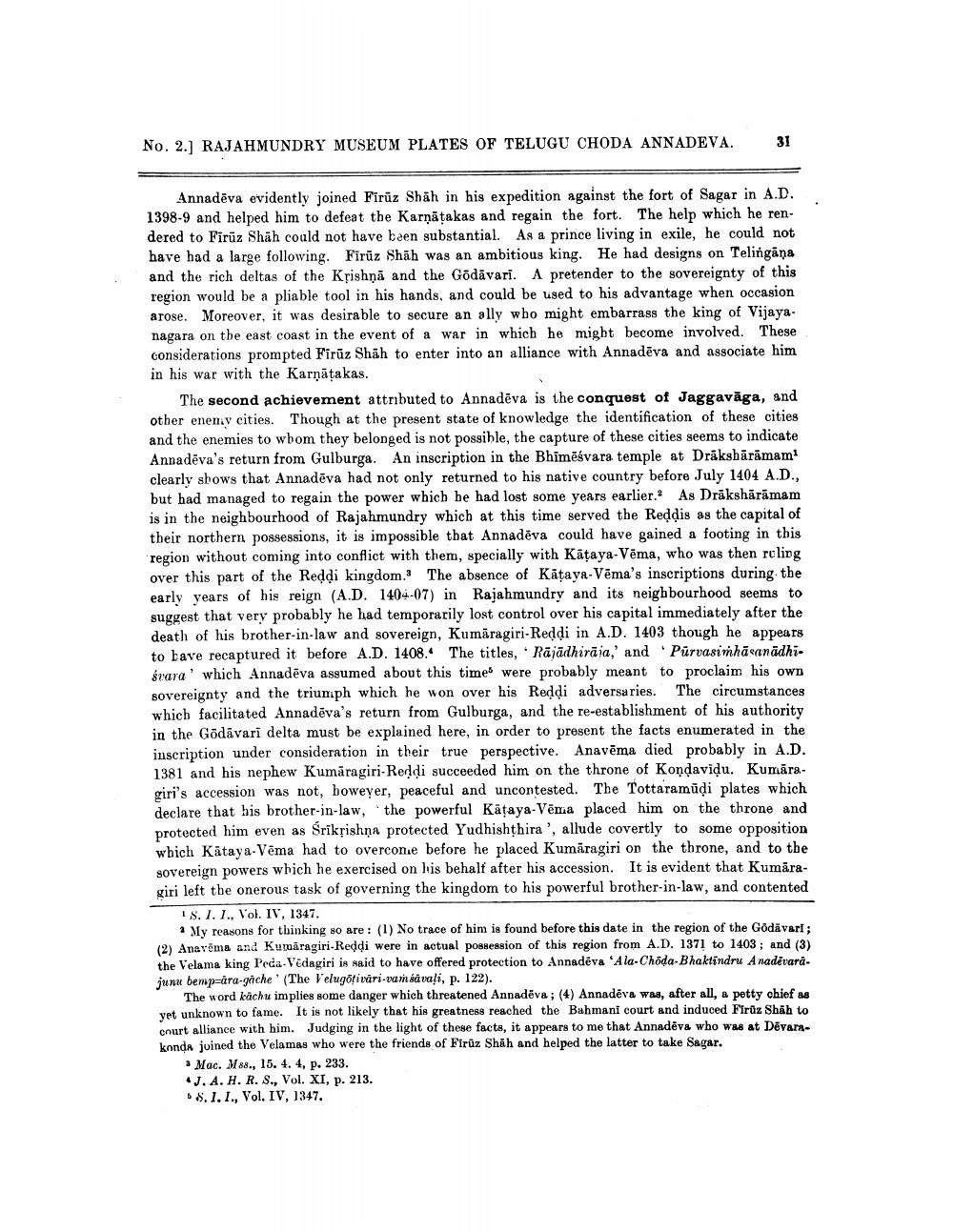________________
No. 2.) RAJAHMUNDRY MUSEUM PLATES OF TELUGU CHODA ANNADEVA.
31
Annadēva evidently joined Firüz Shāh in his expedition against the fort of Sagar in A.D. 1398-9 and helped him to defeat the Karnatakas and regain the fort. The help which he rendered to Firüz Shāh could not have been substantial. As a prince living in exile, he could not have had a large following. Firuz Shāh was an ambitious king. He had designs on Telingana and the rich deltas of the Krishņā and the Godāvari. A pretender to the sovereignty of this region would be a pliable tool in his hands, and could be used to his advantage when occasion arose. Moreover, it was desirable to secure an ally who might embarrass the king of Vijayanagara on the east coast in the event of a war in which he might become involved. These considerations prompted Firūz Shāh to enter into an alliance with Annadēva and associate him in his war with the Karnatakas.
The second achievement attributed to Annadēva is the conquest of Jaggaväga, and other enen.v cities. Though at the present state of knowledge the identification of these cities and the enemies to wbom they belonged is not possible, the capture of these cities seems to indicate Annadēva's return from Gulburga. An inscription in the Bhimēśvara temple at Dräksbārāmam! clearly shows that Annadēva had not only returned to his native country before July 1404 A.D., but had managed to regain the power which he had lost some years earlier. As Dräkshärāmam is in the neighbourhood of Rajahmundry which at this time served the Reddis as the capital of their northern possessions, it is impossible that Annadēva could have gained a footing in this region without coming into conflict with them, specially with Kātaya-Vēma, who was then ruling over this part of the Reddi kingdom. The absence of Kataya Vēma's inscriptions during the early years of his reign (A.D. 1404-07) in Rajahmundry and its neighbourhood seems to suggest that very probably he had temporarily lost control over his capital immediately after the death of his brother-in-law and sovereign, Kumāragiri-Reddi in A.D. 1403 though he appears to bave recaptured it before A.D. 1408. The titles, Räjādhirāja,' and 'Purvasimhāsanādhiśvara' which Annadēva assumed about this times were probably meant to proclaim his own sovereignty and the triumph which he won over his Reddi adversaries. The circumstances which facilitated Annadēva's return from Gulburga, and the re-establishment of his authority in the Godavari delta must be explained here, in order to present the facts enumerated in the inscription under consideration in their true perspective. Anavēma died probably in A.D. 1381 and his nephew Kumāragiri-Reddi succeeded him on the throne of Kondavidu. Kumāragiri's accession was not, bowever, peaceful and uncontested. The Tottaramūdi plates which declare that his brother-in-law, 'the powerful Kataya-Vēma placed him on the throne and protected him even as Srikrishna protected Yudhishthira ', allude covertly to some opposition which Kätaya-Vēma had to overcone before he placed Kumāragiri on the throne, and to the sovereign powers which he exercised on luis behalf after his accession. It is evident that Kumāragiri left the onerous task of governing the kingdom to his powerful brother-in-law, and contented
1S. 1. I., Vol. IV, 1347.
. My reasons for thinking so are: (1) No trace of him is found before this date in the region of the Godavarl; (2) Anarima and Kumāragiri-Reddi were in actual possession of this region from A.D. 1371 to 1403 ; and (3) the Velama king Peda-Vedagiri is said to have offered protection to Annadēva 'Ala-Choda-Bhaktindru Anadēvara. junu bemp=āra-gache' (The Velugotivāri-va sävali, p. 122).
The word kachu implies some danger which threatened Annadēva; (4) Annadēva was, after all, a petty chief as yet unknown to fame. It is not likely that his greatness reached the Bahmani court and induced Firüz Shah to court alliance with him. Judging in the light of these facts, it appears to me that Annadēva who was at Dēvarakonda joined the Velamas who were the friends of Firüz Shah and helped the latter to take Sagar.
Mac. M88., 15. 4. 4, p. 233. J.A. H. R. S., Vol. XI, p. 213. 5.1.I., Vol. IV, 1347.




